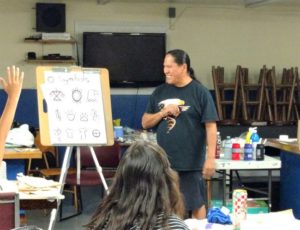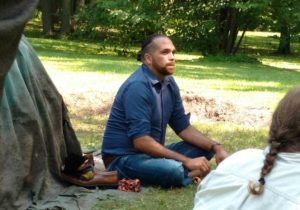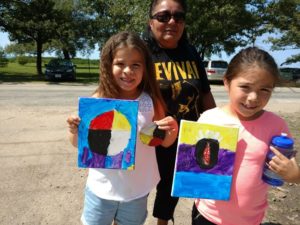Kettle and Stony Point First Nation rediscover cultural roots

By Colin Graf
CHIPPEWAS OF KETTLE & STONY POINT FIRST NATION—Citizens of Kettle and Stony Point First Nation recently gathered to rediscover their cultural roots during their second annual Unity Gathering.
With four days of speakers, workshops, and celebrations, Chief Jason Henry says the gathering has been a chance to “foster some healing and relationship-building”, following events ranging from the legacy effects of residential schooling and the Sixties Scoop. The Kettle & Stony Point First Nation is also recovering from the effects of the Ipperwash relocation where families were removed from their lands to make way for an army base during World War 2, in addition to the fatality of member Dudley George in 1995. George was killed by the Ontario Provincial Police during the re-occupation of the army camp and adjacent provincial park.
The Unity Gathering came out of recommendations in the Comprehensive Community Plan, a multi-year “collective effort to ask the community what they needed for healing,” according to Chief Henry.
Chief Henry says that workshops are conducted by citizens on the theme of “Celebrating our Gifts.”
Keynote speakers during the event included Ashley Callingbull, model, actress, First Nations’ activist, and current Mrs. Universe, along with Jaylynn Wolfe, a 10 year-old award-winning Kettle Point member who started a movement in her school to create a quilt commemorating the Murdered and Missing Indigenous Women and Girls (MMIWG).
“We’re even getting inspiration from our own youth in the community,” says Chief Henry.
Scheduled workshops included storytelling, basket-making, gathering and using the four sacred medicines, healthy relationships, quilting, beading, and canoe safety.
“[The presentations were] a chance for community members to get their feet wet in re-learning and re-discovering our culture,” Chief Henry says.

During his own teaching on fire-keeping, Chief Henry spoke of the tradition of men as fire keepers and the importance of being honest, clean-living, and sincere in order to have the honour of being a fire keeper. Sitting on the park ground, Chief Henry explained the sacred nature of fire, and its importance to First Nations. Even before starting a fire, the keeper should recognize and speak with the spirits of the fire and the wood used to make it, he told the small, attentive group.
“We call to the spirit of the wood, ‘We’re going to cut you down, we’re going to draw you out, and use you for our sacred fire,’” he said.
According to Chief Henry, a keeper should offer tobacco to the spirits and should explain the reason for the fire and add as much detail as possible, so the spirits knows why you are calling them.
“Tell them we’re going to have a sweat lodge today, we want you to come to us, to bring us your energy and be with us.”
Chief Henry says that a man commits to the fire as a fire keeper.
“We’re saying we’re not going to throw garbage on you, we’re not going to throw beer cans on you [to the fire spirit].”
Award-winning Ojibway artist from Kettle and Stony Point Moses Lunham held a workshop for local youth on creating art using First Nations’ symbols, such as thunderbird, turtle, eagle feather, and medicine wheel. During his introduction, Lunham makes sure the young people understand important cultural ideas such as the idea of Turtle Island being all of North America, and that legends teach that their territory is a nesting ground for thunderbirds.
Lunham says he likes to work with children because he hopes to inspire kids to discover if art is “something that could work for them”, as it has in his own life.
“Art is my passion” he says. “[Art has] worked really well in my life…[it] has actually given me a voice. I realized at a very young age I had a gift to be creative and to make art. Now I work with a lot of children in southwestern Ontario First Nations and I see myself in those children.”
Even if youth aren’t inspired to make a future creating art, the artist says his work is helping to teach First Nations’ young people about their culture, through the use of symbols in their artworks.
“Art generates dialogue, generates sharing,” he says.
Adding to the ancient symbols of Anishinabek culture, Lunham also teaches youth that symbols grow out of new awareness of more recent First Nations’ history, such as the orange shirt to represent the legacy of residential schools, and the red dress as symbolizing the MMIWG.
“Our story is changing as we move through the times. These are stories that need to be told, that have emerged in the last five to ten years. The orange shirt and the red dress have become these symbols to represent those stories,” he explains in a post-workshop interview. “I use them a lot more in my work because a lot of the work I do is sharing and teaching,” Lunham says.
Lunham painted one of his recent works, “The Red Dress”, because a friend who lives in Kincardine, Ont., who is very passionate about raising awareness of the MMIWG, asked him to host a paint night. He was inspired by the Red Dress Project, an installation art project coordinated by Winnipeg artist Jaime Black to collect and display 600 red dresses donated by communities across Canada to represent the MMIWG.

According to Chief Henry, Kettle and Stony Point’s first Unity Gathering in 2017, held on the former provincial park site, was really well attended by the community and surrounding communities and set the tone for the future.
“People are together and they’re sharing and they’re celebrating,” he says, recalling how he heard someone say at last year’s Gathering they met cousins they never knew they had.
Chief Henry recounts meeting an Elder once who rephrased the word “community” as “common unity.”
“That’s what these events are doing for us, creating common unity, and that’s a really strong thing.”

